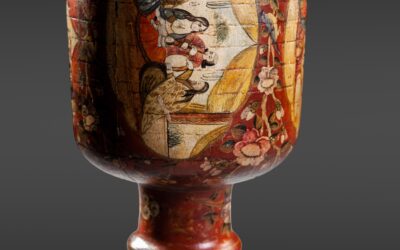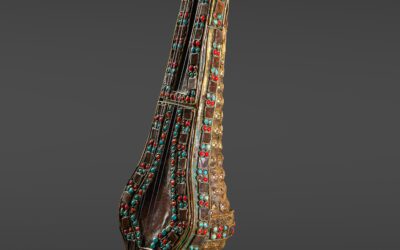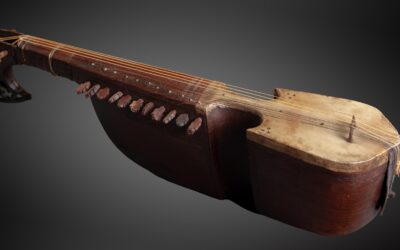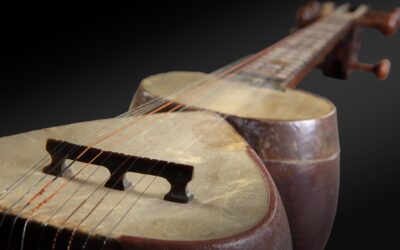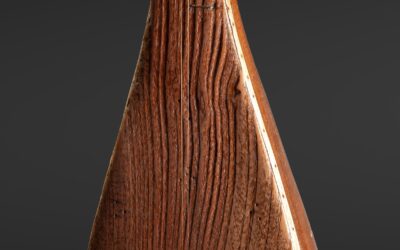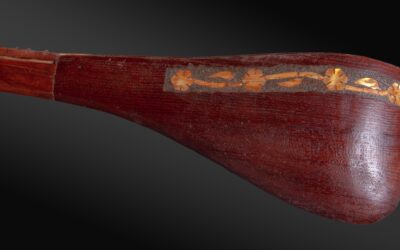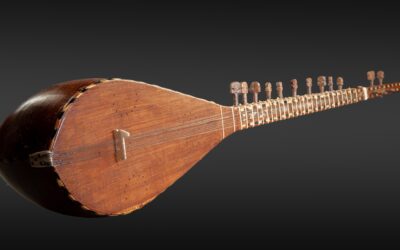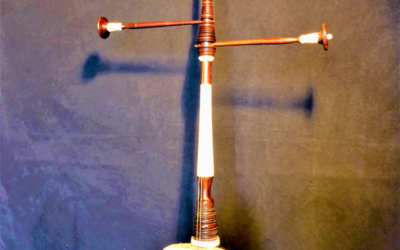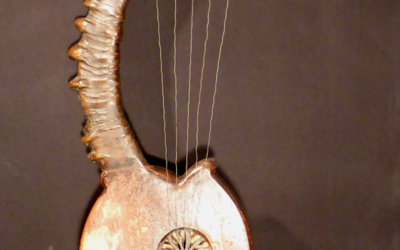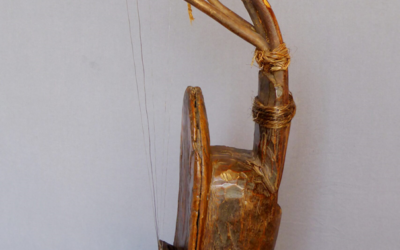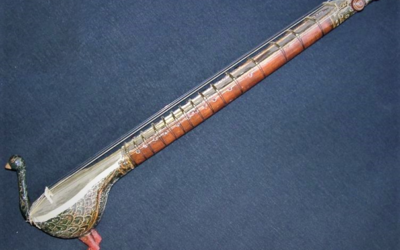DRAMNYEN
DRAMNYENBouthan, 20th century. The dramnyen, which has become the identity instrument of the Boutahn, is an adaptation of the lutes played in the Himalayas, of which the Tibetan Sgra-Snyan is undoubtedly the most famous. Equipped with seven strings including a...
ZARB (DOMBAK)
ZARB (DOMBAK)Iran, 19th century. A goblet drum, the Zarb or Dombak (Zirbaghali in Afghanistan) is cut from a block of walnut or mulberry. It has been known since the beginning of the 19th century. The model presented, with painted decoration typical of the...
CEREMONAL LUTE, SGRA-SNYAN
CEREMONAL LUTE, SGRA-SNYANTIBET Little is known about this type of lute, probably linked to religious processions. The few instruments listed present varied shapes (as do the different models of sgra-snyan from the Himalayas) but with obvious similarities in...
RAVANAHATHA (Ravanhattha)
RAVANAHATHA (Ravanhattha)India 20th century. Rajasthan, Gujarat. Known and described for nearly fifteen centuries, the ravanahatha is represented in Indian mythology as the first bowed instrument, dating from 3000 years before our era... It is made up of a...
SAROD
SARODIndia 19th - 20th century. Directly derived from the Afghan Rabab, the sarod characterizes the dual principle of adoption and adaptation of an object (here a musical instrument), transmitted from one society to another. Brought by Pashtun immigrants from...
DILRUBA
DILRUBAIndia 19th - 20th century. This fiddle, whose construction and playing are between the sarangi and the sitar, was described in the 19th century under the name of Kamancha, then subsequently, the name of Dilruba “which delights the heart” would have been...
RABAB
RABABAfghanistan 19th - 20th century. The instrument is hollowed out of a block of mulberry forming the body and the handle. The fingerboard and pegbox, also in mulberry, are glued during assembly. Eleven sympathetic strings stretched across the side of the...
SARANGI
SARANGIIndia, Rajasthan, 19th century. Monoxyl mulberry fiddle on which a green-tinted sheepskin is glued. (copper oxide?) Eleven wooden pegs arranged along the fingerboard to tighten the sympathetic strings. Four pegs for the melody strings. Bow made of wood,...
DILRUBA
DILRUBAIndia 20th century. This fiddle, whose construction and playing are between the sarangi and the sitar, was described in the 19th century under the name of Kamancha, then subsequently, the name of Dilruba “which delights the heart” would have been awarded...
TAR
TARAzerbaidjan20th century. This lute from the rabàb family is a typical model of Caucasian workmanship in terms of the shape of the body, the organization of the fingerboard, etc. The body is hollowed out of a single piece of mulberry. The resonance table is...
TAMPURA
TAMPURASouth India. Probably from Tanjore (Thanjavur) in Tamil Nadu. The body of the instrument is hollowed out of a trunk of Tun wood (toona ciliata) to which is attached the neck of the same species also hollowed out. Tun's wooden flat soundboard is decorated...
DOTAR of the “SART”
DOTAR of the “SART”Central Asia: Tajiks, Uzbeks and Uighurs. 20th century. “Sart” refers to a vast territory distributed between these different countries and inhabited by sedentary populations. Here, the resonance box is not hollowed out of a mulberry trunk,...
DOTAR (Model n°1)
DOTAR (Model n°1)IRAN, Khorasan province. Afghanistan, Herat province. 20th century. This long-necked lute is played in the east of Iranian Khorràssàn and more particularly around the town of Torbat-e-Jàm, (1) The classically crafted resonance box, hollowed...
DOTAR (Model n°2)
DOTAR (Model n°2)Iran, Khorasan province. Afghanistan, Herat province. 20th century. This long-necked lute is comparable to the previous one and takes on its characteristics. It is played in the east of Iranian Khorràssàn and more particularly around the town...
DOTAR (Model n°3)
DOTAR (Model n°3)Iran, Khorasan province. Afghanistan, Herat province. 20th century. This is the third model of long-necked lute whose brief description we give here: The classically crafted body, hollowed out of a block of mulberry, is recognizable by the...
TANBUR
TANBURCentral Asia: Uzbekistan – Tajikistan. 20th century. The monoxyl body is made of mulberry, bordered with a marquetry of stylized flowers. The soundboard, also made of mulberry, is pierced with resonance holes. The neck, in green oak, is equipped with 25...
DOTAR
DOTARAfghanistan, 20th century. Long-necked lute from the Harati region, (1) around the town of Harat or Herat, in the west of the country not far from Iran and Turkmenistan. The dotar is a long-necked lute from the tanbur family, whose name (dotàr, dutar,...
IMZAD
IMZADTuareg country, 19th – 20th century. Single-string Tuareg fiddle whose sound box is made from a gourd over which goat skin is stretched. The rope is made of a strand of horsehair, and the arch of a simple arched branch. The use of the instrument is...
SANZA
SANZABamiléké country, western Cameroon. Bamoun ethnic group. Materials: Wood, metal. Dimensions: 38,6cm x 31,9cm. Provenance: Agence économique des colonies. Before 1958
SPIKE FIDDLE – RABABA
SPIKE FIDDLE – RABABAEgypt, 20th century. Spike fiddle, of uncertain origin. The oldest known documents are Arabic texts from the 9th and 10th centuries. Al-Jahiz ibn Khurdadhbih and Al Fàràbi, which presents the first description of a bowed instrument. The...
QANBUS
QANBUSMonoxyl lute made in Yemen by Fu'ad al-gu'turi, luthier in Sanaa, who disappeared in 2016 during clashes in the capital. The origins of the instrument appear to come from Central Asia before the start of the Christian era. “This lute would then have...
RAFT ZITHER
RAFT ZITHERYOMKWO. BENIN, first half of the 20th century. century. Idiochord zither composed of fourteen reeds assembled by a ligated bar at each end. The bark of ten of them is split and held up by transverse rods. Provenance: West Africa Economic Agency. (1899-1953)
KAMELE N’GONI
KAMELE N’GONI“Instrument of young men” A harp played in particular by the griots of West Africa, probably originating from Mali, the n'goni is widespread among the Mandingo populations. Small calabash over which a skin is stretched. The handle is made of a rod most...
OUD
OUDMohamed AZOUZ in SKIKDA (ALGERIA) c. 1960. Labelled: "Mohamed Azouz / Music teacher / Luthier. Azzouz Mohamed alias "Elkhaldi" master luthier and musicologist native of Skikda. (at the time Philippeville.) Total length: 89cm. Max width table: 38.5cm
REBAB BALINAIS
REBAB BALINAISVièle à archet originaire du Moyen Orient, jouée dans l’orchestre Gamelan, balinais ou javanais, dans lequel il ornemente la mélodie principale. Fabriqué jusqu’au siècle dernier à partir d’une noix de coco artificiellement déformée et sculptée, le rebab...
BAMILEKE FLUTE
BAMILEKE FLUTEComparable to the Mossi models, these hunting flutes come from the Bamiléké country, on the high volcanic plateaus west of Cameroon.
MOSSI FLUTE
MOSSI FLUTEBurkina Faso, before 1958. Monoxyl flute representing a stylized warthog head. Butkina Fasso. Provenance: Agence Française des Colonies
SIMSIMYYA
SIMSIMYYAHarp-lyre whose use is common to Egypt and Sudan. Traces of it can be found on the other side of the Red Sea along the Arabian Peninsula. This five-string model, more "harp" than "lyre", seems atypical with its "arm" formed of an ibex horn - capra nubiana -...
CENTRAL AFRICAN HARP
CENTRAL AFRICAN HARPZANDE-type MODEL. Former Jacques Carelman collection
N’GONI
N’GONIMID 20th century. Small model made from a tin can, (probably herring-pilchards) on which is fixed a skin stretched by vegetable fibers. The handle is finished with a metal cowbell. Illegible traces of writing on the skin. Length without cowbell: 32.5cm. Total...
PLURIARC type KASAÏ
PLURIARC type KASAÏZAIRE (KUBA tribe, KASAÏ region) CENTRAL AFRICA, CAMEROON… Model with five arms, originating from the Congo. Wood, metal, fiber.
MOROCCAN REBAB
MOROCCAN REBABMonoxyle body surmounted by an openwork wooden fingerboard with rosettes and decorated with bone, mother-of-pearl and brass nails. Total length: 48.5cm. Provenance: former Jacques Carelman collection
SGRA-SNIAN
SGRA-SNIANHimalayan lute. Monoxyle lute from the Arabic "Qambus" family, played in Tibet, Nepal and in different regions of the mountains, under different names.
CEREMONIAL DRUM
CEREMONIAL DRUMPercussion used in Buddhist ceremonies in Tibet, Nepal or Ladakh and Himanaya coutries.. Composed of a red lacquered barrel on either side of which the skins are stretched, it is equipped with the carved handle characteristic of the instrument. Total...
MAYURI or TAUS. South India
MAYURI or TAUS. South IndiaBowed fiddle whose body, sculpted in the shape of a peacock, has its original polychromy. Later head and skin. The red lacquered neck has frets and eleven sympathetic strings. It ends with a polychrome serpent's head. No document consulted...
XIAO
XIAORed lacquered bamboo tube, pierced with six melodic holes. Length: 79.5cm
Address
10 Impasse de Fontenille
03330 Bellenaves
Call me
+ 33 (0)6 64 91 33 06
Send an Email
jmrenard.music@gmail.com

